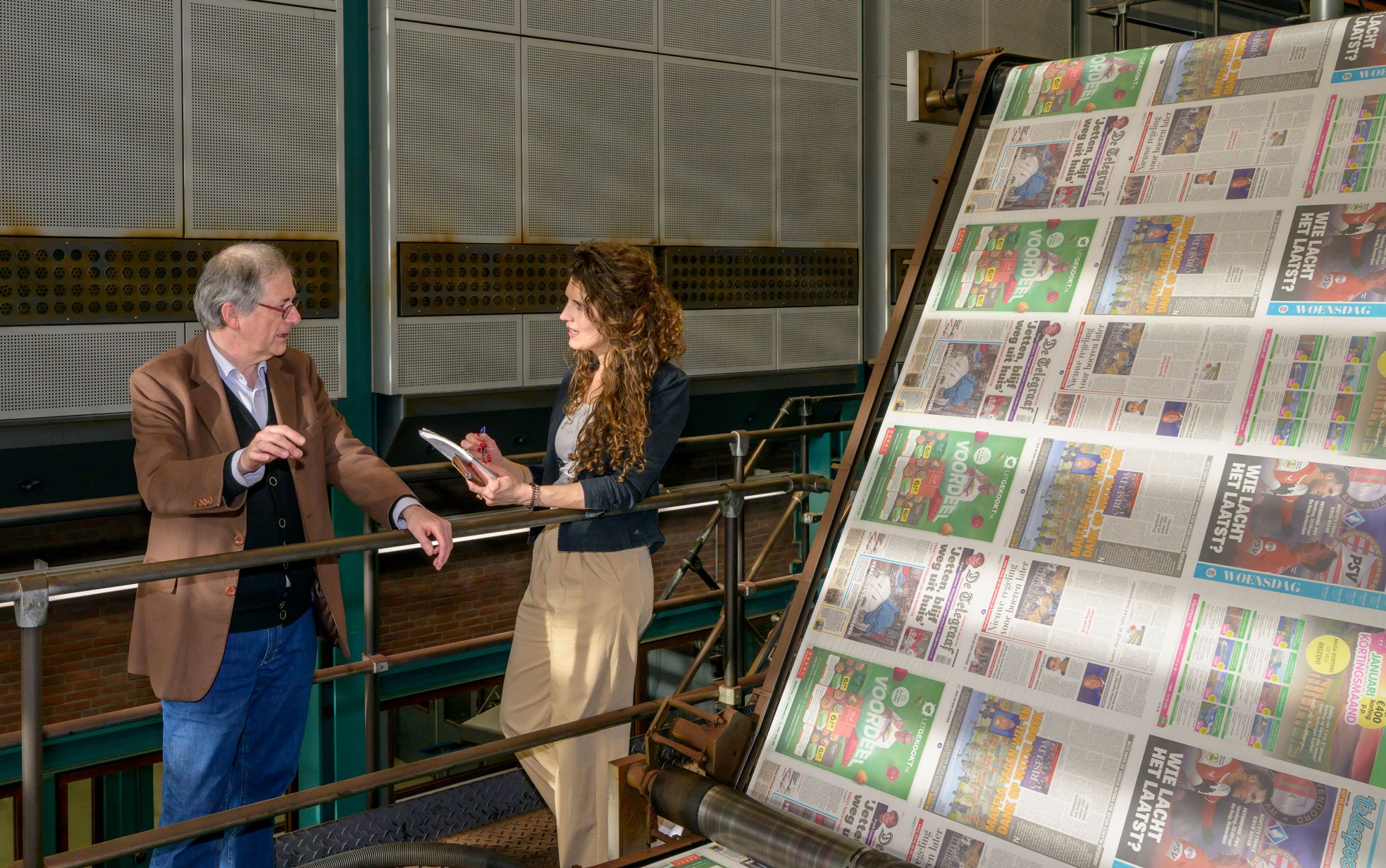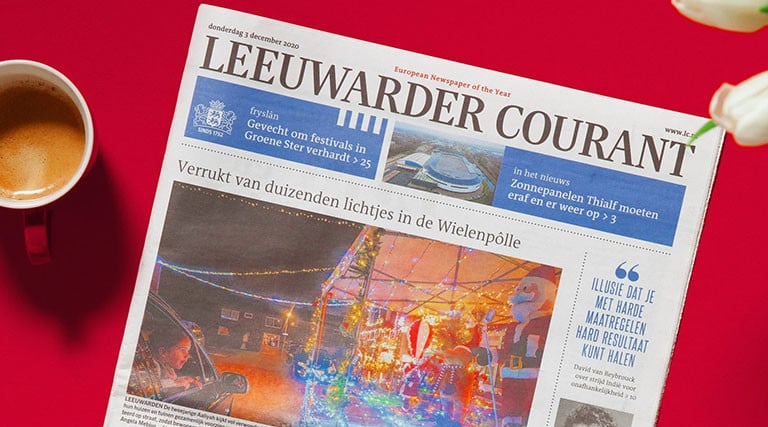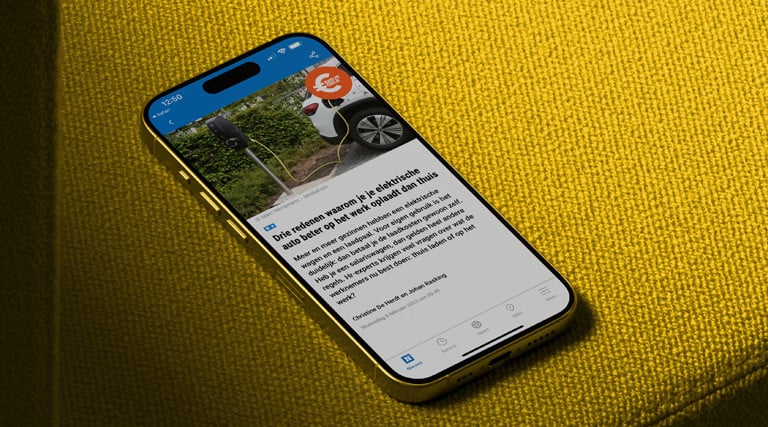
All systems green
Mediahuis' journey towards a sustainable future
Text: Tjerk de Vries | Content director Mediahuis Nederland
Let’s start with the good news: Mediahuis has made great strides to make the company sustainable in all the countries it operates in. We implemented several initiatives in 2023 to achieve the ambitious goal of reducing CO2 emissions.
Heat pump systems for hot water and heating respectively were installed in the printing press in Beringen, Belgium, and the offices in Amsterdam. Luxembourg has a new energy-efficient office and an experiment using small electric trucks began in the Netherlands and Belgium. Aachen, Ireland and Luxembourg are switching to green electricity and the vehicle fleet has been further electrified, meaning that when new leasing contracts are concluded, we will have fully switched to electric driving.
Looking differently at paper
Mediahuis also expects to make progress with a different approach to paper procurement. Declining print circulation means we are buying less paper, but we are also looking at where that paper comes from. Factories with high carbon footprints will lose out to paper producers whose emissions are lower. More paper will come from Scandinavia and less from, say, Canada, because production there is largely produced using grey energy and the boat trip to Europe is long. In Norway, the factory runs on green electricity and the boat trip is shorter, meaning emissions per tonne of paper are lower.
But, of course, we’re not there yet. What is the goal? If we are to meet the commitments set out in the Paris climate agreement to drastically limit global warming to 1.5°C, then businesses as well as governments have to act. To do its bit, Mediahuis is one of the companies that has committed to the Science Based Targets initiative. This framework sets sustainability targets and provides tools for meeting them. And it ultimately checks whether the savings have been achieved.
Every little helps
The emission reduction target is divided into three scopes (see box). In scope 1 and 2, CO2 emissions must be at least halved by 2030; in the third scope, 25% must be reduced. The baseline is 2019. Put simply, it comes down to making every possible adaptation to emit less CO2. This includes smaller office space, cleaner production, electric transport, smarter paper handling, more sustainable heating and the transition from grey to green energy.
While sustainability is not always the cheaper option, Mediahuis believes that cost should not get in the way. Our procurement policy has therefore changed: until two years ago, we always chose the cheapest option when buying paper; now we base our choices on emissions.
Complex calculations
Achieving a goal is rarely easy and it takes perseverance and time. Departments such as e-commerce will also have to make their operations greener. When we buy an electric bike, the CO2 emissions for making such a bike are on Mediahuis’ bill. To reduce or offset that, we need to know how much those emissions are. We are dependent on the manufacturer’s data, which isn’t always easy to find. This illustrates the complexity of the issue. Declaring a CO2 reduction percentage is easy; actually achieving it is another story. But it’s a story that Mediahuis has thrown itself wholeheartedly into. We want to be a company for the future. And that future will be green.
Scope 1
This scope includes direct energy consumption: the energy used to heat offices and run the vehicle fleet and the refrigerants in the air conditioning, for example. To halve emissions in this scope, buildings will be combined and used more efficiently. This will save square metres and reduce the need for heating and cooling. There will also be electric solutions for heating, such as heat pumps. Leased cars will be electric and, if possible, charged using green energy.
Scope 2
This concerns indirect power, the power that we buy. Mediahuis can influence CO2 emissions from that, too, by making the transition from grey power to green power, such as wind and solar. Mediahuis can buy this green power from suppliers or generate it itself using windmills and solar panels. Indirect energy consumption can also be reduce
Scope 3
Among other things, this scope is about the value chain, and the things Mediahuis needs to produce our apps, newspapers and websites. It includes distribution: the vans and trucks that transport our newspapers. E-commerce is included, as are the investments we make in buildings and machinery and in acquisitions of companies. A notable emitter in this scope is the reading behaviour of our subscribers online. Every minute on a website or app has a certain energy consumption and thus CO2 emissions. We have to report that, too. It shows again that CO2 reductions are not easy to achieve everywhere.
Mediahuis wants to achieve a CO2 reduction of at least 25% in this scope by, among other things, buying “greener” paper and buying less. The e-commerce department will also have to look at sourcing that is as environmentally friendly as possible, and at the origin of products. The makers of these products will be asked about their CO2 emissions. Distribution will look at how we can travel fewer kilometres, and the kilometres we do travel will be electric as much as possible.

The newspaper of the future is sustainably printed and delivered
Text: Evelien Engele | Editor-in-chief Mediahuis Nederland regionals
Images: United Photos / Toussaint Kluiters
The hall in the Amsterdam printing press we're standing in is full of rolls of paper brought in by ship. The gigantic rolls weigh about 1,200 kg each. It seems like a huge stockpile, but within a week, this hall will be empty again. Here, and at the three other printing plants in Aachen, Beringen and Leeuwarden, 1.4 million newspapers roll off the press every day, says Paul Huybrechts. Of these, half are for readers in the Netherlands, 27% for Belgium, 11% for Ireland, 8% for Germany and 4% for Luxembourg. Every year, this requires 1,300 tonnes of ink and 97,000 tonnes of paper, either recycled or from sustainably managed forests.
Green challenges
The major green challenges lie in three areas: printing, distribution and, finally, the choice of paper and ink. Of Mediahuis' total CO2 emissions, these three together make up by far the largest share. That includes gas consumption and electricity (which are becoming more and more green) for heating the buildings, e-commerce and emissions caused by distribution.
By printing titles as smartly as possible at its own printers, sharing technological know-how and applying joint purchasing, Paul can say with satisfaction that Mediahuis is operating efficiently when it comes to circulation. “Every printing plant closure reduces emissions,” he says. “Fewer buildings need to be heated and the presses that remain are used much more efficiently, minimising paper waste and reducing electricity consumption per newspaper.”
Given that newspaper circulation is declining, however, further changes are needed, sometimes resulting in earlier closing times. Experience shows that bringing closing times forward needn’t cost readers. “There will be limits, but I’m sure readers will evolve with us in that digital playing field."
“Thinking about what the print newspaper will look like in the future, I’m convinced that the kind of content we have in the paper no longer needs to be the very latest news. Because for that,” – he points to his smartphone – “you can’t beat the speed of the phone.”
Declining print runs combined with the challenge of finding distributors could well lead to the newspaper no longer appearing in print six days a week. One possible move: “Keeping the printers open by printing on fewer days; I think we have flexibility there, especially if the window in which we can print becomes wider.” Less paper and less distribution obviously means a lower carbon footprint. “I don’t know how green a digital newspaper is when you look at the production and recycling of smartphones. That’s another sustainability issue.”
Product with power
Looking ahead to a sustainable future, Paul sees the weekend edition becoming much more of a “product with power”, a different kind of journalism that people are willing to pay more for when they have time to read it. It may well be a case of “back to the future”, he predicts, with the print edition as a niche, luxury product. Inevitably, he says, the cost could increase by 10% in the coming years. Declining print runs will mean printing in fewer places, with longer distances for distribution and exponentially increasing delivery costs. Mediahuis’ sustainability costs are already higher through opting for green electricity and investing in solar panels and heat pumps.
Distribution by e-bike
Zooming in on the distribution side, 30% of delivery drivers in the Netherlands already use an e-bike. While delivery vans previously often ran on diesel, the first electric vans are running in Amsterdam and Antwerp. “The first reactions are positive,” Paul says. “The plan is for Mediahuis to switch entirely to electric delivery vans in the future. When it comes to trucks, it turns out to be more difficult to make them sustainable. We’re not currently sure whether hydrogen or fully electric vehicles are the future, so we’re waiting to see how the sector develops.”
In the hall where the printing plates are made, Paul explains how eight plates are made per tabloid page from each of the four main colours, for both the front and back pages. Whereas in the distant past, plates were made of lead and each one weighed as much as 25 kg, today the wafer-thin aluminium plates are only a few millimetres thick. As many as 100,000 plates are made every week. Ink has a limited carbon footprint impact. “We’re moving towards using ‘green’ ink and will conduct the first tests in 2024. And yes, sustainable ink will indeed be more expensive.” For paper, that doesn’t apply. In fact, the major paper producers are working hard to reduce their carbon footprints.
Purchasing impact
For both ink and paper selection, the greatest possible consideration is given to how sustainable procurement can be. That’s also why paper comes from different sources to minimise the distance between supplier and printer. “There are major differences in the carbon footprint between different paper mills, mainly due to the energy they use in production. We are increasingly working with factories that have a very low carbon footprint, in Belgium, France and Norway.” This is the “purchasing impact” that Mediahuis can have, reducing emissions per tonne of paper. The Amsterdam printing plant’s location in the Westhaven helps, as supplies can arrive there by ship. Paul sees more and more suppliers acting on sustainability on their way to meeting Europe’s climate targets.
Paul is well aware that the lasting changes needed affect routine, habit and emotions. The message to everyone working on the presses in Amsterdam, Beringen and Leeuwarden is a difficult one. “After all, things will change. Over the past decade, we’ve been sufficiently open to change and that has led to where we are today.”
The drive for digitisation means people become less necessary in the process, but certainly not redundant. “Alongside the digital evolution, there will certainly be space for the print newspaper for some time to come. And because that newspaper has to look good every day, it needs people who are motivated: printers, technicians and distributors. Every day.”
Paul points to the coloured pictures in a newspaper, carefully checked under a bright lamp on a reading table next to the presses. “While computers automatically adjust colours, colour combinations remain the trickiest thing. Refinement of colour sharpness, that is the skill of the printer.”

Mediahuis Noord optimises printing press
Mediahuis is constantly examining its existing business-critical processes to see where improvements in efficiency can be made. We look particularly at how we can better align our processes with the digital challenges and what actions can deliver more value for customers. By then making choices, streamlining processes and aligning them more efficiently, we can put more time and resources into the things that really make a difference for our customers.
Using this Lean philosophy of thinking and acting, Mediahuis Noord began work on its printing press, with the goal of improving the start-up phase of the process. Between the start-up of a press and the moment the first clean newspaper rolls off, there is a lot of waste: copies that are imperfect in terms of colour or layout and therefore cannot be sold. This waste cannot be avoided, but it can be reduced. The software that operates the printing process assumes an average waste of 250 revolutions (newspapers). Mediahuis Noord was well above that, with some 648 revolutions. A project team set to work using the Lean method to identify where efficiency improvements could be made. This approach enabled Mediahuis Noord to reduce the number from 648 to 168.

Mediahuis Luxembourg supports local reforestation project
As part of its sustainable development programme and to celebrate the 175th anniversary of the Luxemburger Wort, Mediahuis Luxembourg is supporting an initiative by the local NGO Fondation Hëllef fir d’Natur. The project involves reforesting an area of 8 hectares in the town of Surré in the Luxembourg Ardennes, close to the border with Belgium.
As a result of climate change, many trees in the local woods are struggling to survive. The situation has dramatically changed over the past five years, and large areas of forest are dying off. In the Ardennes alone, in the north of Luxembourg, half of all woodland is at risk. To turn the tide, the Fondation Hëllef fir d’Natur has bought land in order to redevelop it with appropriate plant species.
In addition to a financial contribution from Mediahuis Luxembourg, Luxemburger Wort is calling on its readers, subscribers, advertisers and staff to support the project. Anyone interested can participate in the Plantz Mat! campaign. In the four months since the start of the campaign in September, more than €93,000 in donations has been collected.

Mobility at Mediahuis België is increasingly sustainable
Reducing travel and making it more sustainable and environmentally friendly is something of a mantra at Mediahuis. Together, we continue to actively contribute to a sustainable living and working environment, where our employees’ well-being is central. Our mobility vision is characteristic of this.
The greening of the Mediahuis België vehicle fleet in recent years has happened a lot faster than we had dared to dream. Today, we only choose BEVs, or battery electric vehicles. When all the cars already ordered are delivered, the fleet will consist of 75% full electric vehicles. By the end of 2025 or early 2026, this evolution should mean we have a fleet of only electric cars.
Choosing electric vehicles is great, but more and more employees are taking it a step further. They are opting for other modes of transport, replacing a company car with a mobility budget as an alternative. The rise in the number of lease bikes is also striking: 230 colleagues have chosen a lease bike instead of a company car.
As well as greening the car fleet, Mediahuis België is committed to reducing travel as much as possible. If their job allows it, people can work from home for up to 60% of their normal hours. The hybrid meeting culture gives people the possibility to work together independent of time and place and increases our digital maturity.
